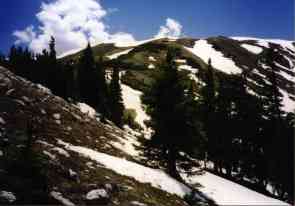
Trips to the A-3D site
The first reconnaissance of the site:
In June of 1998 I decided to work on this one. I started first with a road reconnaissance of the area to find my way to the general trailhead area and to see what kind of terrain was involved.
The area was north and east of Silverthorne in the Williams Fork Mountains. These mountains are the N-S ridges that lie to the north of I-70 an the Eisenhower Tunnel. In my motorcycle trip I got a feel for the land but didn’t get to stay long as I was chased away by a thunderstorm closing in on me. I skeedaddled out of there and didn’t get wet. The mountains are very high with steep sides. Contemplating climbing to the top of the ridge was a rather daunting idea.
The first hike & find of the wreck:
On 30 June I was surprised to have a day off so I decided I’d use that day and try to hike to the A-4 site (note that the CAP listed it as an A-4).
I found the trailhead with no difficulty and started hiking along the trail to the south along a beautiful creek. As I came abreast of the CAP coordinates I tried to find a log or shallow spot to wade the creek. I was unsuccessful as the creek was flowing very fast due to runoff and I didn't care to wade barefoot. I walked the mile back to the bridge near trailhead and crossed the creek and then bushwhacked my way back up the creek. Then I started angling up the hill and climbing. And climbing. And climbing some more. The steepness of the terrain was no surprise but it wasn’t fun. I finally intercepted a creek that flowed out of what on the map looked like a pond around the 10,500’ level and I followed that on upwards. The pond was really more of a wide shallow spot in the meltwater creek.
I found no airplane parts and since I expected to have to go to the top of the ridge I continued on to the west. I did find a small cylindrical object and puzzled a long time over how it must have been blown off the ridge above. There seemed to be no other pieces in the area so I continued onward and upward.
(Click on the pictures to get an enlarged image)
 |
| It's up there (sigh). At least the CAP says so. |
After another hour of climbing I topped the grassy ridge summit and found ------ nice views. No airplane parts. I could see a long ways east, west, north and south. There were no airplane parts up here. I walked a little ways north and south on the snowfields that remained up high and was glad that I'd brought an ice axe instead of my normal hiking stick in case I started sliding down the hill out of control (which didn't happen).
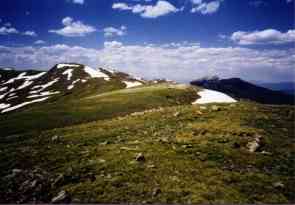 |
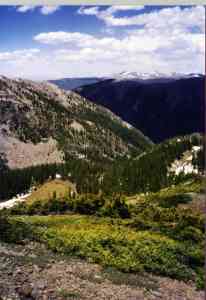 |
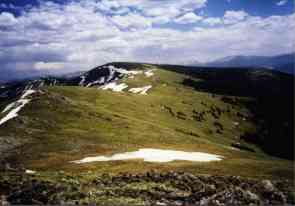 |
| Ridgetop looking North. No airplane. | Looking down at the meadow.
I came up thru the right side of meadow |
Ridgetop looking South. No airplane. |
I descended back down the grassy bowl heading toward the creek when I saw something blue peeking out from under a snowdrift in the trees. After 30 minutes I got close enough to see that the blue thing was a tarp suspended from a low ridgepole and the whole thing was still buried under snow with only the very upper tip of the tarp showing. I dug some snow out to see what was there and found a note. It was written by J.D. Bothun of Winter Park with a phone number. JD had been hunting up there in October and a blizzard had come in during the night. He basically abandoned his equipment and left a note saying he’d come back in the Spring for the gear. When I called him I was afraid that I’d find out he hadn’t survived - but my fear was groundless. He was fine.
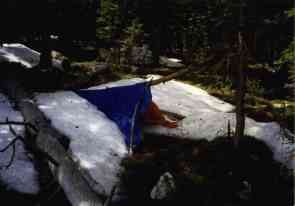 |
| JD Bothun's abandoned camp. |
After that little suprise I continued on my way back to the car staying somewhat to the south of my original path up the hill. Not 100 yds from Bothun’s camp I came upon a parachute. Hot dog!
Descending the hill further I came upon another parachute, a spent flare canister, a parachute harness, and on further down - THE WRECK!!!! Wow! It was 1000’ lower and 0.5 miles east of the coordinates. And at 1530 I didn’t have a lot of time to spend looking. I marked the coordinates with the GPS, took pictures and examined the pieces of airplane that weren’t still under snow. Then I moved on.
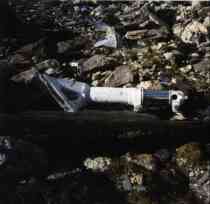 |
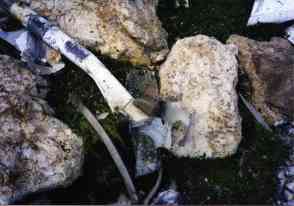 |
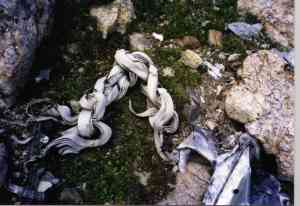 |
| Wheel strut | Tailhook point and shank. | Airplane drag chute lines. |
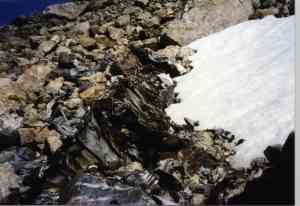 |
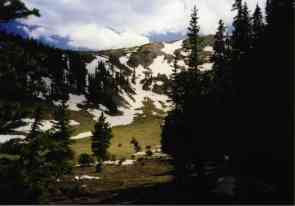 |
| Main center of crash. Much under snow. | Looking at the ridge from parachute area. |
About 30 minutes from the car I started getting leg cramps. Not good. I’d been continuously on the go for 8.5 hrs and now it was catching up with me. Fortunately, I was able to continue to move and gained the car. Another wreck bagged! But, I thought, A-4???? Only the TA-4 would have 2 ‘chutes.... hmmmm.
The day had been 2800’ gained (and lost) and about 3.5 miles of off-trail travel.
The second hike to the site-
On August 9 I returned to the site to see what had melted out. This time I brought along Thomas, my occasional hiking friend (age 16) and Frazier (age 15), another teenager who likes to hike.
This hike went much faster because I knew where the wreck was. It took 2 hard, sweaty hrs to bushwhack from the trailhead alongside the creek and then climb the mountain to the wreck site. (Note- This was before I figured out that wading the creek was far faster)
More material had appeared including the main body of the wreckage that rests on the rockpile.
The boys were fascinated with the parachutes and we poked through the wreckage for awhile.
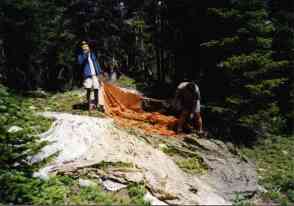 |
| Thomas and Frazier look at a personal chute. |
On this trip I found a melted helmet bag with the fittings from an oxygen mask wadded together with a flight glove and the frames of aviator sunglasses. At this time I didn’t yet know if this was a fatal crash or not so finding these personal items made me somewhat hesitant to dig too much further.
We had an interesting time looking at the pieces and enjoying the view. It took 1.4 hrs to return to the car with no real difficulties. There was no trail and really no particular way to go but descending the hill to the creek and following it downstream to the trailhead was quite simple, if tiring.
Research-
Accident report? What accident report?
I contacted the Naval Aviation Safety Center by email requesting a copy of the accident report for A-4 Bureau Number 142252 using the number from the CAP list. In 3 weeks I received a letter stating that there was no such aircraft. Hmmm.
So THAT’S what it is!
Duke Sumonia had searched the Denver Post archives for the date the CAP reported the crash as having occurred and struck pay dirt. It was an A-3! And the article named the aircrew and stated that they had all bailed out.
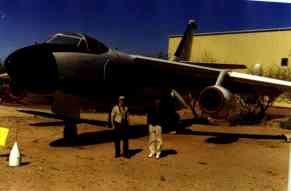 |
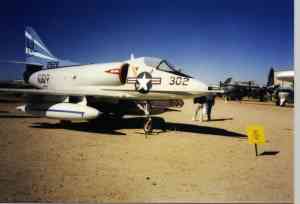 |
| This is an A-3 (Pima Air Museum) | This is an A-4 (Pima Air Museum) |
Duke then pulled a miracle out of the net by logging in to the A-3 Skywarrior Association website and signing the guestbook with a request for the whereabouts of the named crewmembers. Larry Kaiser, the Navigator, and Denny Bird, the Pilot answered up with email addresses.
Over the course of the next month, Duke, Larry Carpenter, myself and my father corresponded with these gentlemen to get the story on this crash. I had prints made of my photos of the crash site and mailed them to Denny as an offering of our interest in their story.
Both Denny and Larry gave us their short version of the crash via email and said that they’d sworn to each other that they would return to the site of "our second chance at life" on the 30th anniversary of the wreck. (That would be 7 August 2000)
After Duke had described the A-3 website, I visited there myself and posted the coordinates for any interested parties. Within a few weeks I got some email from a fellow named Jim Denly who had heard that there was an A-3 down in Colorado somewhere and he’d been a crewman in the early 1960’s in A-3s. Jim was mostly interested in a description of the route to the site. I offered to bring my photos to someplace where we could talk. Ultimately I visited his house where I heard a lot of great stories (Ask him about the Red Baron routine) and where Jim opened his logbook to find that 142252 was the very last bird he’d flown in the Navy. He’d flown in this bird about 4 years before the crash. Great coincidence, eh?
More recon-
During the Spring and summer of 1998 email discussions continued with Larry and Denny as my father explained his Navy history and his interest in the wreck. We all basically got acquainted via email and Dad and I discussed going together on my annual "mogabout." My annual Jeep trip has normally been in September after Labor Day and the family calls it my "walkabout." "Mogabout" seems like a nice adaptation. . We schemed on how to hike to the A-3 site.
On July 11, in anticipation of yet another visit to the site I made a solo trip to the wreck site to see if I could determine the least arduous route to the plane. The simplest way is to hike the trail on the wrong side of the creek then wade the creek in flip-flops before going nearly straight up the hill. At a full-snort effort it took me 1 hr. 45 minutis from car to wreck and I arrived with my t-shirt soaked from neck to belly-button. 1:15 for the return. This will be a challenge for just about everyone.
As August came along, Larry mentioned that he was having a conference at Whidbey Island Washington one weekend during our scheduled mogabout and that he could meet us in Colorado and try to go to the wreck site. He’d been skiing here many times and knew some things about the area and so he arranged for a room at the Super 8 Motel in Silverthorne and we planned to meet there on Friday night of that weekend and hike to the site on Saturday.
I think Larry got more and more excited because he invited his friend Bob Newsome to come from Utah for the event and his grown daughter, Cristina, flew in from Atlanta for the event as well.
For our part, Jim Denly came along and invited 2 church friends, and Larry Rushing, a fellow H-P employee who’d been hiking to wreck sites after I’d found them decided to join in the fun.
Finally September came and Dad and I set out on Mogabout ‘99. We headed out one week before the A-3 party and did some high-altitude training for Dad. We parked and hiked halfway to the F-100 wreck site and then returned. This was a good training event by getting some exercise at altitude a few days before the big A-3 hike and is the basic plan used by mountaineers to adapt to altitude- stress, recover, stress, recover.
We had a very fine week of crystal-clear weather and cold nights preceding the move to Silverthorne.
The A-3 reunion event-
Dad and I had been out camping for nearly a week beforehand including camping one night at the trailhead for the wreck and fishing the creek and letting Dad get the feel for the land. On Friday morning as we left the area we took a sidetrip up a road heading east with the possibility of getting a view of the wrecksite and our hike. Unfortunately this didn’t really work out since we were actually 9 miles by GPS from the site with no direct view. Still, we had a nice leg-stretching hike and a fine morning before we eased on into Silverthorne and checked into the Super 8. We needed, and took, showers and then looked around awhile before running into Jim Denly checking in. He’d bumped into Bob Newsome in the parking lot so we went to shake and howdy with Bob.
Eventually Larry and Cristina arrived and we went to dinner at a noisy restaurant and tried to tell stories over the din.
Story 1- What were they doing in Colorado?
The squadron had been doing carrier qualifications on the East Coast with the USS John F. Kennedy. In a wonderful coincidence, the Squadron/Signals Publication The A-3D Skywarrior is a picture of 142252 (this very airplane) sitting on deck on the JFK just 8 days before the crash. The also used this very airplane for the painting and detailed drawing foldout in the book.
After doing the qualifications, the flight of 3 aircraft was returning to their home base at Alameda, Ca. They’d landed at Lowry AFB to refuel. They’d had a little bit of a problem getting airborne on the first try and had had to abort into the field arresting gear with the arresting hook and drag chute. After about 2.5 hrs recovering from that escapade, the 3 aircraft departed Lowry with around 24,000 lb of fuel aboard. This aircraft was the flight lead because the next most senior pilot’s aircraft had been having radio troubles.
As they climbed out westbound thru 21,000’ Denny requested clearance to higher altitude to avoid a layer of clouds at 21,000’. Passing 24,000’ the aircraft abruptly pitched up. Denny added power to keep from stalling before the aircraft could stall. It was not responding to pitch inputs and remained pitched up.
Denny was not quite quick enough to try to roll it to keep it from departing from controlled flight and so it did.
The A-3 was not equipped with ejection seats. This was a design decision made in the early days of jet design where the best that a bang-seat could do was to punt the rider above the tail. The A-3 was equipped, instead, with a chute/slide arrangement under the feet of the crewman which, when activated, blew the belly panel off the airplane, and aligned just like a wide children’s playground slide to allow the crew to slip out of the airplane where they would pull their parachute D rings and open their chutes.
The crewman and rider were bailed out above 20,000’. Larry was next to dive down the escape chute.
But to his, and Denny’s terror, the seat cushion for the crewman’s seat hadn’t retracted to its spring loaded UP position. Larry’s chute was hung up on the seat preventing him from sliding down the ramp and out of the airplane. Larry was stuck face-down in the escape chute in a falling airplane.
Denny saw this and tried to go out the overhead hatch. The cockpit has a very small overhead escape hatch but Denny, being the pilot, didn’t know how to operate it at that moment. He stood there trying to figure it out, couldn’t and then found that Larry had somehow cleared the escape slide and so he dived out after Larry.
Denny says that once outside he grabbed the D ring and deployed the chute immediately since he knew he was in mountainous terrain. He swung once and touched down on grass about 100yds from the fireball created by the crashed airplane.
Larry pulled his D-ring and says he swung 3 times before smacking face-first into a rocky cliff losing 8 teeth. Larry was on a ledgy cliff area also within 100 yds of the wreck site. Larry worked his way down the cliff and joined Denny on the grass above the burning wreck.
The two crewman weren’t seen again by Larry & Denny for several weeks. One had been forced to spend the night out because he hadn’t been located before nightfall. The other was recovered the same day. They'd been whisked off to medical checks immediately and processed separately from the Pilot and Navigator.
One interesting sidelight to note at this point is that one week earlier a new Parachute Rigger had reported to the squadron and had uncovered the devastating fact that the periodic re-packing of chutes on their defined schedule had been ‘gundecked’ and that the chutes were not receiving their proper checks. This PR had repacked all the squadron chutes including these 4. His discovery and corrective work might have saved several of these men’s lives. It would be nice to know this man’s name and whereabouts so that his name could be written here as a man who did the right thing at the right time.
The two officers inventoried the damage and took stock of their situation. One important question was the issue of how much daylight was left. This information would help them decide whether to work on making shelter for the night or not. It is an indication of the shock in the situation that Larry says he was sort of stunned after the landing. He really wasn’t too sure how he’d gotten there and couldn’t remember much about the flight and the bailout. In addition, neither he nor Denny could figure out whether to add or subtract 2 hrs to correct from Eastern Daylight Time, which Larry’s still-running watch showed, in order to get to Mountain Daylight Time. Larry says they never did figure that out. Larry also reminds Denny that his fancy-shmantsy Seiko watch had stopped running from the bailout. Denny had waited a year for Seiko to replace the crystal which had popped off one day. Then, when they found themselves in the woods, the watch wasn’t running.
The two other A-3s of the squadron orbited overhead giving Denver Air Traffic Control center a fix on the location of the bailout and announcing the nature of the emergency. Unfortunately, the aircraft had to depart the area before anyone could talk to them on the personal radios so there surely were some anxious hours aboard those planes as they headed home.
In survival school aircrew had allegedly been taught how to cope with just this situation with firemaking and shelter building but things didn’t go very well for Larry and Denny. Denny tried to build a parachute teepee over a tree and was going to start a fire to keep Larry warm. Larry was concerned that he might be going into shock from his facial injuries and laid on one of the liferafts that were part of each flyer’s bailout kit. Larry knew how to build a good, safe lean-to but with his busted up jaw and the swelling that started, he could only mumble and that wasn’t sufficient instruction to Denny. Larry says he was sure he’d die from smoke inhalation before they were rescued.
After 4 hours on the mountain Denny spotted a helo flying over a ridge and was able to call on the personal radio to get their attention and then popped a smoke canister. The helo, a UH-1 Huey, landed in the grassy elk meadow 200 yards above the crash site. Larry was placed on a stretcher and they climbed in. The helo had been out searching for them but was low on fuel and had been headed home when they’d happened to have come across the flyers.
Larry related the story that as he was being loaded on the chopper he heard someone, probably the Crew Chief, say that the helo was too heavy to take off at that altitude. Larry thouht to himself " Oh boy, I’ve been in one crash already today and here we’re going to try for another one......"
The helo pilot was confident that the takeoff would work and and fortunately he was proven correct.
The two were taken to Lowry hospital and examined. Denny was treated and released while Larry spent a few more days in the hospital for his broken, and wired shut, jaw.
Both Denny and Larry stayed in the Navy and made Captain and retired. They stay in contact with each other and have had interesting lives. Larry transitioned into EA-6 Prowler aircraft and the electronic intelligence and countermeasures business. Larry says he never, ever, flew without his oxygen mask tightly cinched onto his face again.
Saturday AM- Of all days..... Saturday morning dawned cloudy, misty and with snow lying on the mountains all around us. The group partook of the free breakfast in the lobby of the Super 8 and eyed the weather. It wasn’t actively snowing in the parking lot which was about as optimistic as we could get. So, since there was no other day to do the hike, we headed off to trailhead.
Once at trailhead it was still cloudy and misty and the woods were very damp but it wasn’t outright raining. JD Bothun, the hunter, was there (I’d invited him as well) and so we had a party of 10 on this gray, damp day. We set off at 0900.
It was quite remarkable that even on a damp day with a large party of mixed capabilities, we just climbed the hill to the meadow above the wreck. It took 3 hours but there was no drama involved - just hard work.
JD lead the way and talked the whole time keeping minds off of the hard work being accomplished.
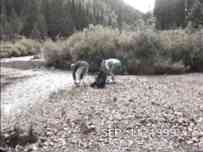 |
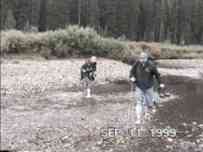 |
| Preparing to cross the creek. | Larry and Ron cross (it's cold!) |
At about 1130 he lead the group up next to the creek that I’d first found that single part and we stopped to find piles of other pieces in the woods. This was about 300 yds and over a ridge hummock from the wreck site. Then JD led us to the elk meadow where the UH-1 had landed and rescued the flyers. One of the parachutes was draped over a log ridgepole. JD had found the chutes years back and had used one for an informal hunter’s shelter one year. While standing at the parachute Larry began relating the stories and the situation. One could picture the young men and their predicament 29 years before as Larry talked.
One thing that might not be apparent yet today is how incredibly lucky they were to have jumped out during summer months. August is probably the most benign time of year in the Williams Fork Mountains at 11,200’. If they’d jumped in January or any other winter month, those 4 hrs on the ground would probably have proven fatal. This is something that truly sank into my consciousness during the trip.
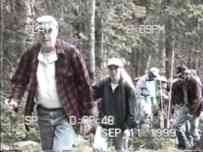 |
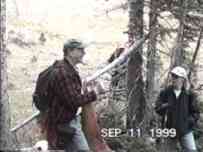 |
| "If anybody asks, tell 'em we're
having fun." |
Larry describing the rescue as Cristina
looks on. |
After Larry told us about the helo liftoff, we moved a bit east to the other parachute and then we stepped over the brow of the hill to see the crash site.
Larry beelined for the rocky cliffs and climbed quite a ways in an effort to try to figure out where he had landed. He wasn’t sure whether his helmet was on his head when he landed so part of the cliff climbing was to look for his helmet and possibly his teeth. Meantime, the rest of the party descended on the wreckage and began inspecting it. There was no wind that day so the sound of people picking up pieces of aluminum and then dropping them was a continuous sound. It rather resembled shoppers in a metal flea market with the miscellaneous clanking from all quadrants.
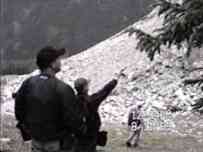 |
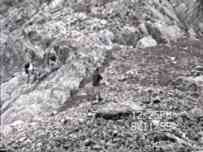 |
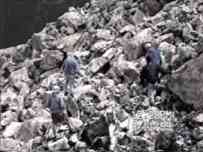 |
| Larry points out where he landed.
(Note the camera date is set wrong. |
Larry looking for lost teeth where
he landed 30 yrs ago. |
The guys pick over the wreck. |
We had arrived at the wreck at 1200 and the weather cooperated somewhat in that it never rained but stayed gray and somewhat cool. The cool temperature was good for the hard work of the climb but once we reached the wreck and the activity level dropped to that of standing and inspecting, people began to get cold and most of us put on all our warm clothes. Larry came down off the rockpile and helped turn over pieces of the airplane and point out and name certain parts. Folks stuffed their lunches in their mouths as they viewed the parts. At one point Jim Denly made a big show of lifting the tailhook to his shoulder. The tailhook is a very, very heavy piece of metal. Jim did not try to wrestle the hook home (though he DID get it home the next year).
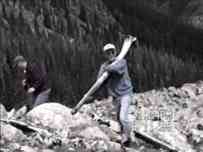 |
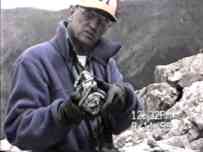 |
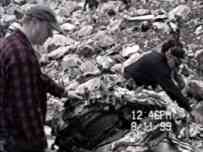 |
| Jim Denly hefts the tailhook. | Ron Miller (Sr) contemplates a
slightly used gyro. |
Larry looks over an engine. |
After 2 hours on the wreck, folks were cold and we had a pretty hard hike to get back to the car. A few dataplates were scrounged for souveniers and we headed down the hill.
Downhill is good in that you are not working against gravity but it is bad in the sense that it’s pretty hard on knees and the muscles one uses for descending usually aren’t as strong as the climbing muscles. Hiking sticks came in handy for easing the burden and for keeping balance. It took about 2 hrs to descend to the creek. After the refreshing crossing it was then a matter of plodding back to the car. Larry did amazingly well for a guy from low altitude and not a lot of physical preparation. Maybe it was the Naval Aviator thing about having to look good for the audience.
We reached the cars intact with no saggers, slackers or injuries and so we headed back for the motel. On the dirt road along Williams Fork creek a cow moose and calf jumped out in front of Larry’s car and ran in front of it for a ways. The calf was the size of a horse. The cow was bigger. Welcome to Colorado!
The group arranged to go out for dinner and did so after a rest and a shower but Larry was absolutely wiped out and stayed in bed. Cristina brought him some chicken soup. He'd had the flu the week before and combined with the heavy exertion at altitude, his body was rebelling.
The next day, Larry and Cristina left early for the airport to put her on a plane back to Atlanta. Bob Newsome had departed as well and there was no one there but us Millers.
During the Winter of 1999/2000 more email was exchanged. Denny Bird had planned to join Larry at the wreck site on 7 August 2000. Unfortunately, this trip wasn't to be due to various personal circumstances.
But we sure hope it can happen someday and will do everything possible to make it go well when it does.
Last Modified: 1/1/2008